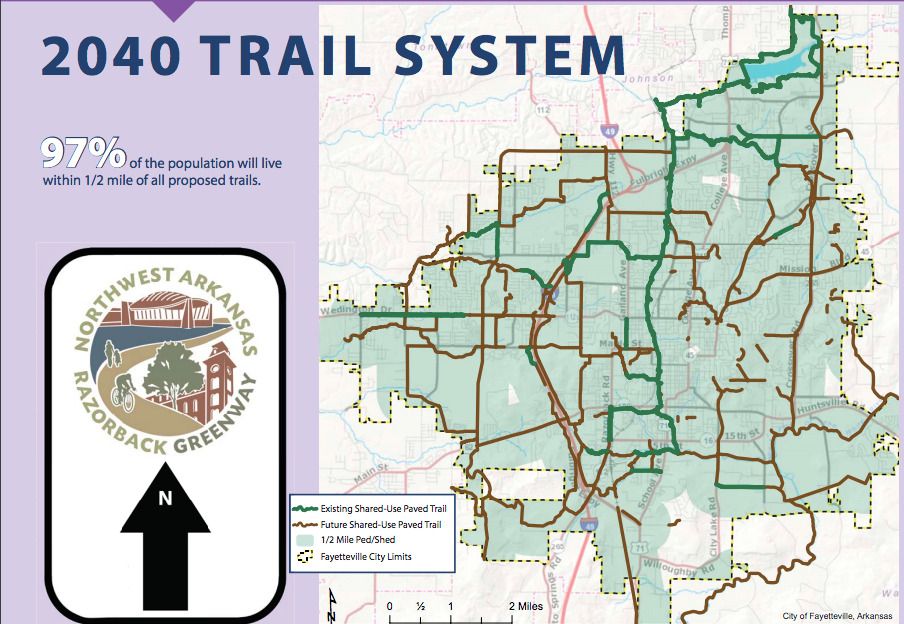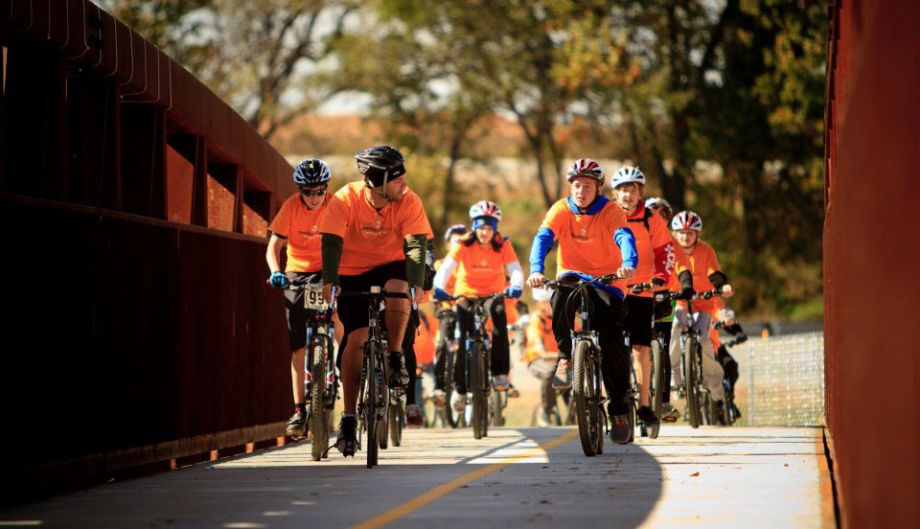“If you go out on our [bike] trails, you see a lot of diversity relative to this area. Cycling has become so accessible that we have people of all ages in the community using the trails,” says Dane Eifling, Fayetteville, Arkansas’s mobility coordinator in its engineering division. “Cycling has become normalized,” he says, and it’s no coincidence.
Fayetteville has been busy investing in its bike infrastructure recently, to the point that Places For Bikes, a national bike advocacy organization, recently gave Fayetteville an “acceleration” score of 4.6 out of 5, meaning the city is improving its bike infrastructure faster than any other ranked cities. The scores are based on how many people in the region are riding bikes, how extensive and connected the city’s bike infrastructure is, and other factors.
“If you have a bunch of big roads that aren’t bike friendly and you can’t really bike anywhere without getting on a road, your score goes down,” explains Eifling. “But if you have trails and neighborhood streets that will get you to a destination, then your score goes up.”
In Fayetteville, that’s exactly what’s been happening. “We’ve been building out a lot of trails and our paved network” over the past several years in particular, Eifling says. “Developments and destinations are being added around the trail network and it’s become a self-fulfilling process,” he says — as more trails and connections get built, more developments select to be near the trails. Thanks to the city’s annually updated master plan, anytime a new business is approved next to a trail, the business has to build a connection to the trail. The city also has dedicated construction resources working in its favor. The engineering department has an in-house trails crew of nine people dedicated to building all trail types throughout the city.
Gulley Park is an excellent example of one such build out. “It’s one of our most visited parks. It has a great concert series and gets a lot of visitors everyday, but it was completely cut off from any bike routes because it’s located along an old highway. Ninety-nine percent of the time you were going to drive to the park unless you lived across the street,” he says.
Over the last few years, the city built a bike trail that connected the park to the nearly 40-mile Razorback Greenway that slices through the city.
Improvements like this are thanks in large part to the adoption of an Active Transportation Plan in 2015. The plan defines active transportation as any form of human-powered transportation, from cycling to wheelchairs. Among the plan’s goals is to have a trail connection within a half mile of every residence by 2040. The city also pledged to earn a silver Bicycle Friendly Community designation by 2017, a milestone it hit a year early.

(Map: City of Fayetteville)
The city’s convention and visitor’s bureau, Experience Fayetteville, even has a dedicated cycling coordinator — Brannon Pack, previously executive director of a nonprofit dedicated to mountain biking. Pack says that many of Fayetteville’s improvements illustrate the CVB’s belief that both recreational and professional cycling are key sources of tourism dollars in both Fayetteville and greater Northwest Arkansas.
To that end, the city hosted the U.S. Pro Cup, the highest level of professional cross-country mountain bike racing in the country, for the first time this April.
The city will also host the 2022 UCI Cyclo-Cross World Championships — only the second time ever that the race will be held outside of Europe. The cycling organization that governs the sport internationally has recognized that Fayetteville has been heavily investing in the necessary infrastructure for road and mountain bike hybrid race to the point that it gave its first and only Bike City designation in the U.S. to the city.
What all of this adds up to for Eifling is an overall increased accessibility to cycling in the city.
Beyond seeing international cycling events on the regular, the comfort and safety of the city’s trails has been a game changer. “We have lighting on them at night in most areas — we’re focusing on bike transportation 24 hours a day, which translates to more usage when people feel safe,” Eifling adds. The hope is that new users can build confidence and skill on the paved trails, which will lead to an increased interest in and ability to see biking as both a sport and a common mode of transportation.
The plan in Fayetteville is to keep on keepin’ on. While the city has roughly 50 miles of trails within its limits currently, the city’s bicycle master plan was updated last year with an aggressive goal to double that number to 100 miles of paved trail networks in the next ten years to meet the Active Transportation Plan’s half-mile connection goal.
“We’re always looking forward,” Pack says. Especially with the Pro Cup race this year, “we’re seeing some of that pay off.”

Cinnamon Janzer is a freelance journalist based in Minneapolis. Her work has appeared in National Geographic, U.S. News & World Report, Rewire.news, and more. She holds an MA in Social Design, with a specialization in intervention design, from the Maryland Institute College of Art and a BA in Cultural Anthropology and Fine Art from the University of Minnesota, Twin Cities.
Follow Cinnamon .(JavaScript must be enabled to view this email address)
















